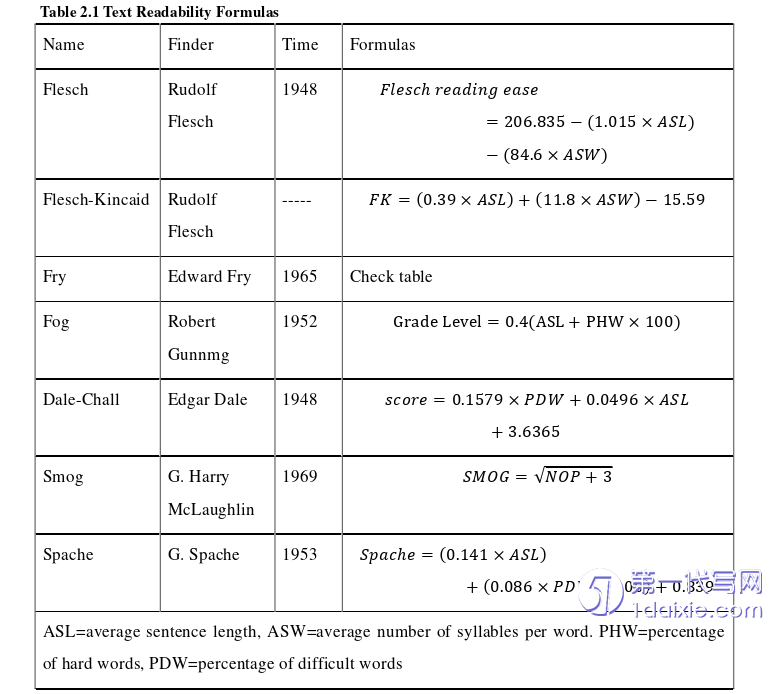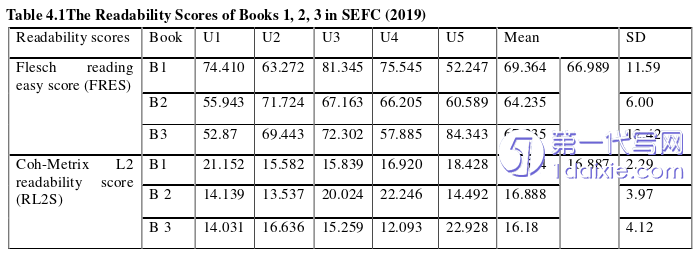本文是一篇英语论文,本研究以2019版人教版高中英语必修教材和2020版沪教版高中英语必修教材中的主要阅读语篇作为研究对象,以克拉申的输入假说和系统功能语法为理论基础。
1 Introduction
1.1 Background of the Study
As one of the three components of classroom instruction, textbook is the major resources used by teachers to teach language and students to acquire knowledge. Thus, whether the complexity of the textbook corresponds to the students’ learning needs and level is related to the quality of language education (Yang & Xu, 2017), and text readability is an important indicator of measuring the difficulty of the text (Zhu, 2015). The curriculum standards provide important guidance for the measurement of text readability. In China, the English Curriculum Standards for Compulsory Education (2017 Edition) established instruction standards in terms of reading speed, the number of new words learned, and reading comprehension rate. In reading instruction, textbooks at various levels of learning supply relevant reading texts for teachers and students, and teachers are responsible for designing reading instruction based on vocabulary, lexical difficulty, syntactic difficulty, and article length. And in the National English Curriculum Standards for General High School (2017 Edition, revised in 2020) (the Curriculum Standards), the English class in senior high school is supposed to prepare the groundwork for students to continue growing in English throughout their life. It emphasizes the holistic development of pupils’ language abilities, cultural awareness, critical thinking abilities, and capacity for learning (that is, the core literacy of English subjects). English textbooks are core aspects of the English curriculum and instruction, acting as both pedagogical and content resources, it is also the primary material for achieving the goals of the English course. Moreover, because textbook is the main tool for teachers to teach, the curriculum standards state that “teachers should be adept at utilizing textbooks in a flexible and creative manner, and they should be capable of making suitable trade-offs and modulation to the content, sequence, and teaching methods of textbooks in response to the actual needs of teaching” (Liu & Wu, 2011).
1.2 Purposes of the Study
The author compares the readability of the main reading texts in two different versions of the compulsory students’ English textbooks for SEFC (2019) and SHSE (2020), as well as the readability of the main reading texts with the degrees of reading power (DRP) values, the goal is to evaluate the readability of the main reading texts from four indicators. Specifically, the author compares the readability of the main reading texts for SEFC (2019) and SHSE (2020) at the macro level of readability score, and at the micro level of lexical difficulty, syntactic complexity, and cohesion in order to explore the readability features of the main reading texts, as well as the differences and similarities in the main reading texts between SEFC (2019) and SHSE (2020) in the aspect of readability, and then the author tries to give some teaching suggestion to use the textbook and give some suggestion to learning the textbook for students,.

2 Literature Review
2.1 Definition of Key Concepts
2.1.1 Textbook
A textbook, alternatively referred to as a course book, plays a crucial role in English teaching and learning. Experts and scholars at home and abroad hold divergent perspectives on textbook. Some scholars believe that textbook is the physical manifestation of curriculum content. The textbook is the materialized form of curriculum content and the concrete embodiment of the primary content of the curriculum and syllabus (Ren, 2002). Richards (2001) pointed out that the syllabus specifies the language learning content by organizing language components or learning tasks such as structure, themes, concepts, and functions; the textbook further specifies the subject content, defines the scope and intensity of the syllabus items covered, and suggests implementation, allocating time, effort, and details according to the specific requirements of a particular syllabus entry or task. In Ashley’s view, the textbook serves as a medium of teaching through which complicated political and historical contexts, as well as sociolinguistic practices, are presented (McGrath, 2002). Language teaching and learning are not ideologically neutral activities; they are embedded in a complex web of political, historical, and sociolinguistic contexts, all of which are mediated through the textual and visual worlds of textbook. As most textbooks are made by publishers with the goal of making money, they tend to be aligned with the dominant ideologies of the structural parts of those complex webs.
There are both broad and narrow definitions of “textbook”. In a narrow sense, an English textbook refers to “a book, the teacher and each student usually have a one, which should be systematically followed under normal circumstances, as the basic to express the content of the language course” (Ur, 1996). Thus, the English textbook serves as the primary instrument for students to use in the classroom to acquire and enhance their language skills. In a broad sense, English textbooks are made up of all the materials that are used to teach a language, like textbooks, workbooks, audiotapes, CDs, and videos. Photocopies and a paragraph written on a blackboard in a newspaper are also part of the English textbook.
2.2 Theoretical Foundation
2.2.1 Krashen’s Input Hypothesis
In the early 1980s, Krashen proposed the input hypothesis for the first time. Krashen (1985) believes that humans develop language through the comprehension of messages or the receipt of understandable input. “Input” regards as the language materials of potential targets encountered by learners, as well as the various language cues provided by the surrounding environment, such as spoken language and written language signals. Furthermore, Krashen believes that two fundamental conditions must be met to facilitate language acquisition, one is that the learner obtains an adequate amount of comprehensible input, and the other is that learners possess an inherent mechanism for processing input language. If someone wants to acquire a language, he or she needs to input a lot of language knowledge (Luo & Li, 2000).
There are four characteristics of Krashen’s input hypothesis (Li, 2013). (1). Comprehension. According to Krashen, comprehension of the input language is an essential requirement for language acquisition. If the learner is unable to comprehend the inputs, he will be unable to acquire the language. (2). Interesting and relevance. This suggests that the input materials should be appealing and related to the students’ daily life. In this way, learners can acquire the language easily and unknowingly. non-grammatical sequences. (3). Enough comprehensible input. Since language acquisition is the natural acquisition of a language by exposing learners to a large amount of intelligible input in a natural language environment. It is more important to provide comprehensible input materials rather than organize teaching according to grammar procedures. (4). Sufficient input. Krashen asserts that learning a new language requires not only practice, but also frequent communication and content-rich reading. Thus, teachers can provide multiple reading materials that follow the rule “i+1”, so students can have the chance to improve their language competence and performance. The rule “i+1” means that the content of the input materials should have an appropriate “information gap”. That is, in the rule “i+1,” “i” is the learner’s existing cognitive level, and “1” is slightly higher than “i” level (Dai, 2010).
3 Research Design ............................... 37
3.1 Research Questions ............................ 37
3.2 Research Subjects .................................. 37
3.3 Research Methods ........................ 39
4 Results and Discussion ................................... 46
4.1 Readability Scores ..................................... 46
4.1.1 Readability Scores of SEFC (2019) ............................ 46
4.1.2 Readability Scores of SHSE (2020) ........................... 48
5 Conclusion ................................. 71
5.1 Major Findings ................................ 71
5.2 Implications of the Study ..................................... 73
5.3 Research limitations and Future Study ......................... 75
4 Results and Discussion
4.1 Readability Scores
The main reading texts in the two versions of textbooks are input into Word office, and then analyzed by Coh-Metrix 3.0 tool. The Flesch reading easy formula is a common way to measure readability scores with a single dimension. The Coh-Metrix L2 readability formula, which measures a combination of dimensions. As a result, the authors measured two different readability scores for the main reading discourse, they are Flesch reading easy score (FRES) and Coh-Metrix L2 readability score (RL2S). In the following, the authors will analyze readability scores of the main reading texts in SEFC (2019) and SHSE (2020).
4.1.1 Readability Scores of SEFC (2019)
Table 4.1shows the readability scores for 15 texts in three textbooks of SEFC (2019), there are five units in textbooks from Book 1 to Book 3, and these scores are from Flesch reading easy formula and Coh-Metrix L2 readability formula and called Flesch reading easy score (FRES) and Coh-Metrix L2 readability score (RL2S). Along with the FRES and RL2S for each main text, the “mean” FRES and RL2S for each book is also calculated. What’s more, the column labeled “SD” contains numerals showing the standard deviation of the measure for the RDFRE and RDL2 of the main texts.

5 Conclusion
5.1 Major Findings
There is no significant difference between the main reading texts of the SEFC (2019) and SHSE (2020), and the main reading texts writing and selection maintain a more stable level of readability at the text level. However, there were some differences in some indicators in the readability analysis between the two versions of the textbooks. In addition, the author also compared the main components of readability of main reading texts in the textbooks of SEFC (2019) and SHSE (2020) with the DRP value of readability of reading texts in English Language Arts provided by the CCSS, and the following are the main findings by the author.
For readability scores, the FRES of the main reading texts of these two versions textbooks were distributed in the difficulty level of fairly difficult to easy (50-90). In addition, the FRES and RL2S of the main reading texts of both versions of the textbook were not significantly different from the DRP values; the comparison between the two versions also revealed no significant difference between the FRES and RL2S of the main reading texts of the two versions of the textbook. However, FRES is lower in B1than them in B1 and B3, and from B1 to B3, they did not show a trend from high to low in SEFC (2019), because the number of words is fewer in B2, RL2S show a trend from high to low in SEFC (2019), the result indicates that Flesch reading easy formula has a single measure of text readability, while Coh-Metrix tool’s measure of text readability is comprehensive and holistic.
On lexical difficulty, the main reading texts in the SEFC (2019) were consistent with the DRP value in the aspects of the number of words, vocabulary diversity, word length (mean), word concreteness. The main reading texts in the SHSE (2020) were insignificantly different from the DRP value except for the vocabulary quantity. In addition, the vocabulary quantity of the main reading discourse in the textbook of the Human Education version was significantly different from the number of words of the main reading texts in the textbook of the SHSE (2020) and the number of words of the main reading texts in the textbook of the SEFC (2019) were less than that of the main reading texts in the textbook of the SHSE (2020).
reference(omitted)
